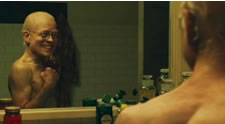Five Screenwriting Tips For A Hot Summer
Part 2 of our "Survival" series for screenwriters:
- DON'T BE THE PERFECTIONIST
- WHY I WALKED OUT ON LITTLE CHILDREN
- DUMP THE CUT TO'S
- AVOID FLASHBACK PING-PONG
- WHY I WALKED OUT ON BENJAMIN BUTTON
 Three Oscar wins, dozens of awards and nominations around the globe. Great blood lines with the F. Scott Fitzgerald source material. Incredible effects, beautiful look to the film. Brave performances by Pitt and Cate Blanchett. What's your problem with this one, genius? Why walk on it?
Three Oscar wins, dozens of awards and nominations around the globe. Great blood lines with the F. Scott Fitzgerald source material. Incredible effects, beautiful look to the film. Brave performances by Pitt and Cate Blanchett. What's your problem with this one, genius? Why walk on it?
Because it booooored me!
2 1/2 hours? Of what? Felt like I was trapped watching a slide show of Benjamin Button's life. "In the 20's I was..." "In the 40's I was..." Structurally perfect sequences, but dull. I always feel a bit guilty telling folks I walked on Benjamin Button for...Paul Blart, Mall Cop! Truth be told, I'd do it again!
 Examine your process - how you write the script. Let's say you've outlined your script. You've blocked out time and are coming at it with good energy. You barricade yourself in with a copy of Baudelaire's Flowers of Evil, 18 bottles of Pabst Blue Ribbon or whatever it takes to get you rolling. The pages come out, but look like crap. What the $#@*! Why?! Remember this scene in Amadeus?
Examine your process - how you write the script. Let's say you've outlined your script. You've blocked out time and are coming at it with good energy. You barricade yourself in with a copy of Baudelaire's Flowers of Evil, 18 bottles of Pabst Blue Ribbon or whatever it takes to get you rolling. The pages come out, but look like crap. What the $#@*! Why?! Remember this scene in Amadeus?God speaking to you lately? It doesn't happen. There are going to be so many rewrites, polishes, trims, tucks, cuts...the script in constant revision mode. Don't be a perfectionist. Don't keep rewriting the same 30 pages.
I've seen good writers lose confidence this way. They can't get the scene down, but they won't let it go. You have to push forward. That's the purpose of the rough "discovery" draft. Push forward, say everything you want to say in rough form. If, at the end, you're looking at 140 pages, so what? You'll know what needs to be done by the time you reach the end. Don't censor yourself. Push out. Get the rough draft done, then refine.
Trust yourself!
 I made a vow: "If I hear that voice over again, I'm walking." There's Kate Winslet approaching a playground: "Many times Mary would take her child to the playground." Kate swings her kid in the swing. "She loved to swing her kid on the swing." Kate looks to a gaggle of women chatting at the merry-go-round. "There would often be other mothers there gossiping." Voice over, if used at all, should not describe what we're seeing directly. Good voice over is indirect. It delves into the mind of a character for insights that are essential to the scene, insights we can't see.
I made a vow: "If I hear that voice over again, I'm walking." There's Kate Winslet approaching a playground: "Many times Mary would take her child to the playground." Kate swings her kid in the swing. "She loved to swing her kid on the swing." Kate looks to a gaggle of women chatting at the merry-go-round. "There would often be other mothers there gossiping." Voice over, if used at all, should not describe what we're seeing directly. Good voice over is indirect. It delves into the mind of a character for insights that are essential to the scene, insights we can't see. If you're using voice over, please, examine the necessity of it. What's your voice over adding that we can't discover visually? This is not to say it can't be done well. Road To Perdition, Goodfellas, American Pyscho, Forrest Gump all had voice over essential to the narrative.
Still found-for whatever reason- in Final Draft software under the "Transition" tab, CUT TO is a useless and redundant device. Why would I need CUT TO to indicate a new scene? A slugline, by definition, indicates a new scene.
I've heard the argument that they help visualize the movie, a hard cut looks different from a dissolve. That is a director/editor's call, not the Spec Screenwriter. You want you script visual? Don't slow the reader's eye with 100+ pointless CUT TO's. Dump 'em.
Bouncing from FLASHBACK to PRESENT is not ideal. Like voice over, use FLASHBACKS if there's no other way to tell the story. Use FLASH TO's for shorter time frames, to go into a character's mind for a recollection or moment. FLASH TO's appear in movies as five or ten second bursts of memory, as visions of the past, but are not flashbacks. You never leave the present moment; only go back in time inside the character's mind, then return just as quickly to the present. Do not force the reader into reading the visual equivalent of ping-pong. If you can tell the story without any flashbacks, do it.
Updated: 07/28/2011
ScriptLinks
Post Your Script Here!Rescuing Atlas - Xanadu Shores III:
“Rescuing Atlas” the trilogy’s peak begins when an astrophysicist - megalomaniac and boat racing enthusiast, operating from his island, becomes hell-bent on blackmailing the world.
Eternal Blessings
An ex-con spends her final hours on earth inside a time portal wound back to 1985, there, she sets out to retrace the origins of her crime and make peace with her past.
In the Shadow of the Kingmakers
Pilot prologue When a British agent suspects his ruse to entrap an American diplomat might be exposed by a Persian teen, and a British nurse, his investigation lures him into a deeper turbulent spy war over Iranian oil in the 1920s.
FURGROW BIRDS SPIRITUAL ROSE
When a dog loses his owner and home, he discovers a dark conspiracy involving an evil king, a hidden realm, and God's magical crystals used to alter the world.
Furgrow Birds back to the beginning
When a dog loses his owner and home, he discovers a dark conspiracy involving an evil king, a hidden realm, and God's magical crystals used to alter the world.
GERIATRIC PARK
A young man with a dark past finds a job as a Handyman in a nursing home.
Fight For Oil
A beautiful young anti-war activist and a Death Valley auto mechanic learn about love and loyalty during a future Gulf War.
Promises, Promises
Life crisis. Mid-life crisis.
Fish Fetish
What happens when you mix compulsion with alcohol? A horrific, fast paced story of abuse and revenge inspired by "Tales From The Crypt"
Med Frenzy - A Conspiracy
A single woman encounters an unknown international skin ailment and cannot get medical help, but in her desperate search for relief discovers the cause and a conspiracy between powerful government and industry entities—but who can she trust to investigate her claim? 9 locations



